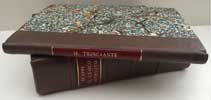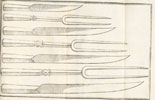IL TRINCIANTE.
D M. VINCENZO CERVIO, AMPLIATO, ET RIDOTTO A PERFETTIONE DAL CAVALLIER REALE FVSORITTO NARNI, Trinciante dell’Illust [with small MO above]. & Reur [with small MO above]. Signor Cardinal Farnese CO’ PRIVILEGII. [Illustrated Printer woodcut device in homage to Sybille. Surrounded on 3 sides by--] QVAL PIV FERMO – E IL MIO FOGLIO – EL MIO PRESAGIO. IN VENETIA Appresso gli Heredi di Francesco Tramezini. M D LXXXI.
FIRST EDITION 1581. 3 feps. Title page very slightly age browned with 3 small ink spots not detracting. [1] 1p ALL ILLVSTRISS. 2p Ai Lettori. 1p TAVOLI. 1-44[1] 3 feps. 3 plates of carving knifes & forks, fowls ready for carving with parts labeled, and a three times folded long plate of knifes and forks. The main text in italic type. Bound in quarter dark brown calf with marbled boards and red morocco and gilt label. The whole text-block very clean. Overall in fine condition.
- Vincenzo Cervio (ca. 1510-1580) was for most of his life an officer in the household of Cardinal Alessandro Farnese, and was also a famous carver. Il Trinciante, (translated; The Carver), is his posthumous book that was edited by Cavalier Reale and includes a separate section by Reale. It is stated online the book is the forerunner to all other books and manuals on carving. This is not true. It is preceded by the first treatise on the Italian art of carving by Giovanni Francesco Colle and his work; Refugio del Povero Gentilhuomo. Colle was the trinciante to the Court of Ferrara. His treatise was published in 1520 and dedicated to Duke Alfonso d’Este. Cervio's work tho' is said to be superior to all the essays of his predecessors including Domenico Romo, who wrote The Singolare Doctrine, pub: Venice 1560. This rare first edition of Cervio's Il Trinciante of 1581 is published in the original Italian, and details the carving and serving of meat, fish, fruit, shellfish and fowl. It includes no fewer than 74 chapters and promotes the Italian method of carving, where one holds the food up in the air with a fork and carves it in this posture, transforming the operation into a spectacular performance for the diners to admire. The treatise, moreover, provides "much information about the foods eaten at an Italian court of that period" (Davidson). The chapter on household matters concludes with a short piece on the carving tools designed by Fusoritto da Narni, author of at least a portion of the work. These are depicted in detail on the folding plate. Fusoritto da Narni was, in this period, trinciante to Cardinal Alessandro Mont’al- to whose uncle Felice Peretti (Sixtus V) was pope from 1585-90. It is probable that the elaborate banquets described are ones in which Narni officiated. A 2nd edition was printed in Rome in 1593 by Giulio Burchioni and in the same year the 2nd was reprinted again in Venice by Giovanni Varisco. It was also published in early seventeenth century and was often bound together with later editions of Bartolomeo Scappi’s ‘Opera’. This book is a glimpse of the elite of Italian Renaissance society and the skills of the carver as one of the important functions of their dinners and banquets. BMC STC Italian, p 166. USTC 821713 - 7 copies. Vicaire, col. 159; Westbury, pp. 45-46; 1 x 1581 & 2 x 1593. The 1st edition not in Bitting. Horn-Arndt; cf. Davidson, The Oxford companion to food, p. 156. Cagle 2 copies 1581 & 1593. Mags Cat.# 645 one copy of 1591. Mosimann has a 1st plus 2 others.





click on image to enlarge

Antiquarian category
ref number:
11221